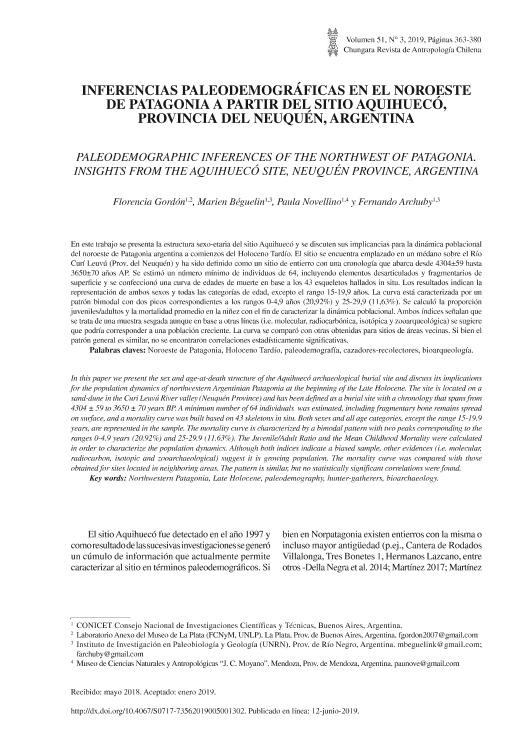Mostrar el registro sencillo del ítem
dc.contributor.author
Gordón, Florencia

dc.contributor.author
Beguelin, Marien

dc.contributor.author
Novellino, Paula Silvana

dc.contributor.author
Archuby, Fernando

dc.date.available
2021-03-10T02:05:29Z
dc.date.issued
2019-09
dc.identifier.citation
Gordón, Florencia; Beguelin, Marien; Novellino, Paula Silvana; Archuby, Fernando; Inferencias paleodemográficas en el noroeste de Patagonia a partir del Sitio Aquihuecó, provincia del Neuquén, Argentina; Thomson Reuters (scientific) Ltd; Chungará; 51; 3; 9-2019; 363-380
dc.identifier.uri
http://hdl.handle.net/11336/127873
dc.description.abstract
En este trabajo se presenta la estructura sexo-etaria del sitio Aquihuecó y se discuten sus implicancias para la dinámica poblacional del noroeste de Patagonia argentina a comienzos del Holoceno Tardío. El sitio se encuentra emplazado en un médano sobre el Río Curí Leuvú (Prov. del Neuquén) y ha sido definido como un sitio de entierro con una cronología que abarca desde 4304±59 hasta 3650±70 años AP. Se estimó un número mínimo de individuos de 64, incluyendo elementos desarticulados y fragmentarios de superficie y se confeccionó una curva de edades de muerte en base a los 43 esqueletos hallados in situ. Los resultados indican la representación de ambos sexos y todas las categorías de edad, excepto el rango 15-19,9 años. La curva está caracterizada por un patrón bimodal con dos picos correspondientes a los rangos 0-4,9 años (20,92%) y 25-29,9 (11,63%). Se calculó la proporción juveniles/adultos y la mortalidad promedio en la niñez con el fin de caracterizar la dinámica poblacional. Ambos índices señalan que se trata de una muestra sesgada aunque en base a otras líneas (i.e. molecular, radiocarbónica, isotópica y zooarqueológica) se sugiere que podría corresponder a una población creciente. La curva se comparó con otras obtenidas para sitios de áreas vecinas. Si bien el patrón general es similar, no se encontraron correlaciones estadísticamente significativas.
dc.description.abstract
In this paper we present the sex and age-at-death structure of the Aquihuecó archaeological burial site and discuss its implications for the population dynamics of northwestern Argentinian Patagonia at the beginning of the Late Holocene. The site is located on a sand-dune in the Curi Leuvú River valley (Neuquén Province) and has been defined as a burial site with a chronology that spans from 4304 ± 59 to 3650 ± 70 years BP. A minimum number of 64 individuals was estimated, including fragmentary bone remains spread on surface, and a mortality curve was built based on 43 skeletons in situ. Both sexes and all age categories, except the range 15-19.9 years, are represented in the sample. The mortality curve is characterized by a bimodal pattern with two peaks corresponding to the ranges 0-4.9 years (20.92%) and 25-29.9 (11.63%). The Juvenile/Adult Ratio and the Mean Childhood Mortality were calculated in order to characterize the population dynamics. Although both indices indicate a biased sample, other evidences (i.e. molecular, radiocarbon, isotopic and zooarchaeological) suggest it is growing population. The mortality curve was compared with those obtained for sites located in neighboring areas. The pattern is similar, but no statistically significant correlations were found.
dc.format
application/pdf
dc.language.iso
spa
dc.publisher
Thomson Reuters (scientific) Ltd

dc.rights
info:eu-repo/semantics/openAccess
dc.rights.uri
https://creativecommons.org/licenses/by-nc/2.5/ar/
dc.subject
NOROESTE DE PATAGONIA
dc.subject
HOLOCENO TARDÍO
dc.subject
PALEODEMOGRAFÍA
dc.subject
CAZADORES RECOLECTORES
dc.subject
BIOARQUEOLOGÍA
dc.subject.classification
Arqueología

dc.subject.classification
Historia y Arqueología

dc.subject.classification
HUMANIDADES

dc.title
Inferencias paleodemográficas en el noroeste de Patagonia a partir del Sitio Aquihuecó, provincia del Neuquén, Argentina
dc.title
Paleodemographic inferences of the northwest of Patagonia: Insights from the Aquihuecó site, Neuquén province, Argentina
dc.type
info:eu-repo/semantics/article
dc.type
info:ar-repo/semantics/artículo
dc.type
info:eu-repo/semantics/publishedVersion
dc.date.updated
2021-03-05T18:31:58Z
dc.identifier.eissn
0717-7356
dc.journal.volume
51
dc.journal.number
3
dc.journal.pagination
363-380
dc.journal.pais
Chile

dc.journal.ciudad
Arica
dc.description.fil
Fil: Gordón, Florencia. Universidad Nacional de La Plata. Facultad de Ciencias Naturales y Museo. División Antropología; Argentina. Consejo Nacional de Investigaciones Científicas y Técnicas. Centro Científico Tecnológico Conicet - La Plata; Argentina
dc.description.fil
Fil: Beguelin, Marien. Universidad Nacional de Río Negro. Sede Alto Valle. Instituto de Investigaciones en Paleobiología y Geología; Argentina. Consejo Nacional de Investigaciones Científicas y Técnicas. Centro Científico Tecnológico Conicet - La Plata; Argentina
dc.description.fil
Fil: Novellino, Paula Silvana. Consejo Nacional de Investigaciones Científicas y Técnicas. Centro Científico Tecnológico Mendoza. Museo de Ciencias Naturales y Antropológicas J. Cornelio Moyano; Argentina. Consejo Nacional de Investigaciones Científicas y Técnicas. Centro Científico Tecnológico Conicet - La Plata; Argentina
dc.description.fil
Fil: Archuby, Fernando. Consejo Nacional de Investigaciones Científicas y Técnicas. Centro Científico Tecnológico Conicet - La Plata; Argentina. Universidad Nacional de Río Negro. Sede Alto Valle. Instituto de Investigaciones en Paleobiología y Geología; Argentina
dc.journal.title
Chungará
dc.relation.alternativeid
info:eu-repo/semantics/altIdentifier/url/https://scielo.conicyt.cl/scielo.php?script=sci_arttext&pid=S0717-73562019005001302&lng=en&nrm=iso&tlng=en
dc.relation.alternativeid
info:eu-repo/semantics/altIdentifier/doi/http://dx.doi.org/10.4067/S0717-73562019005001302
Archivos asociados
